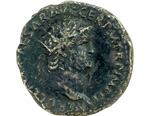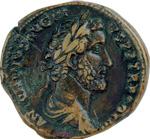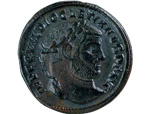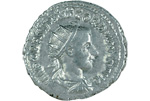Guide to Ancient Roman Coinage
Like coinage of today, Ancient Rome's coins represented portions of larger denominations. The As, the basic unit, functioned like our penny. And like our penny, through inflation it experienced a loss of buying power. During the time of the Roman Republic, you could buy a loaf of bread for ½ As or a liter of wine for one As. A year's pay for a commander in the Roman army around 133 B.C. was 10-2/3 Asses, by Augustus' rule (27 B.C.-A.D. 14) 74 Denarii, and by the reign of Septimus Severus (A.D. 193-211), it rose to 1,500 Denarii.
|
|
Below is a brief description of the most common denominations issued in the Ancient Roman Empire.
As

Initially, the As was cast in bronze. Later, with reduction in weight, it was small enough to be struck with coin dies. With Augustus' coinage reforms in 23 B.C., this coin was struck in copper and showed the emperor with a bare or laureated head. By the rule of Valerian and his son Gallienus in the middle of the 3rd century, the As was infrequently struck.
Dupondius

Worth two Asses; literally means "two-pounder," but even during the Roman Republic it didn't weigh 2 pounds. Though this brass coin was more yellow in color, it was still easily confused with the As. Under Nero, the emperor, it began to show an emperor with a radiate crown.
Sestertius

Originally a small silver coin issued around 211 B.C., the Sestertius was worth 2½ Asses. Under Augustus it became a large "golden" orichalcum (brass) coin, worth 4 Asses. Its large size allowed emperors to commemorate victories, triumphs or virtues as rulers. By the 3rd century A.D., the Sestertius had become a smaller bronze coin, and after Gallienus' reign (A.D. 253-268), it was no longer minted.
Follis

Emperor Diocletian first minted the Follis, a bronze coin with a minute amount of silver (usually a wash), around A.D. 294. Because of the chaotic state of the empire, it rapidly underwent changes, decreasing in size and weight.
Reduced Follis
Through time, economic changes forced a reduction in size and weight of the bronze Follis. It was gradually reduced under Constantine, and eventually replaced after the end of the Constantinian Era.
Denarius

This standard silver coin of the Roman Empire depicted an emperor wearing a laurel wreath. First issued around 211 B.C., it started with 5% alloy, and over the years the alloy was increased, until by the reign of Septimius Severus it reached 50%. The Denarius disappeared from circulation around the time of Gordian III (A.D. 238-244).
Antoninianus

Caracalla first minted the Antoninianus around A.D. 211. It is named for him: M. Aurelius Antoninus "Caracalla." This silver coin shows the emperor wearing a radiate crown as opposed to the laurel wreath of the Denarius. Starting with 40% silver, this coin was gradually debased to a silver wash. Finally, it was abolished during the reign of Constantine the Great (A.D. 307-337).
Siliqua

A small silver coin first issued by Diocletian, originally called the Argenteus. Later reintroduced as a Siliqua under Constantine the Great, this coin weighed 1/96th of a Roman pound, but its exact place in the monetary system and its value are not known.
Aureus

Standard gold coin of the Roman Empire. First issued regularly under Julius Caesar around 46 B.C. Although it was reduced in weight, through time, the gold content remained consistently high. The Aureus circulated until A.D. 309 when Constantine the Great replaced it.
Solidus

Gold coin minted by Constantine the Great, replacing and weighing less than the Aureus. This coin, later struck by the Byzantines, endured for seven centuries as a circulating gold coin used for commerce in Europe.

